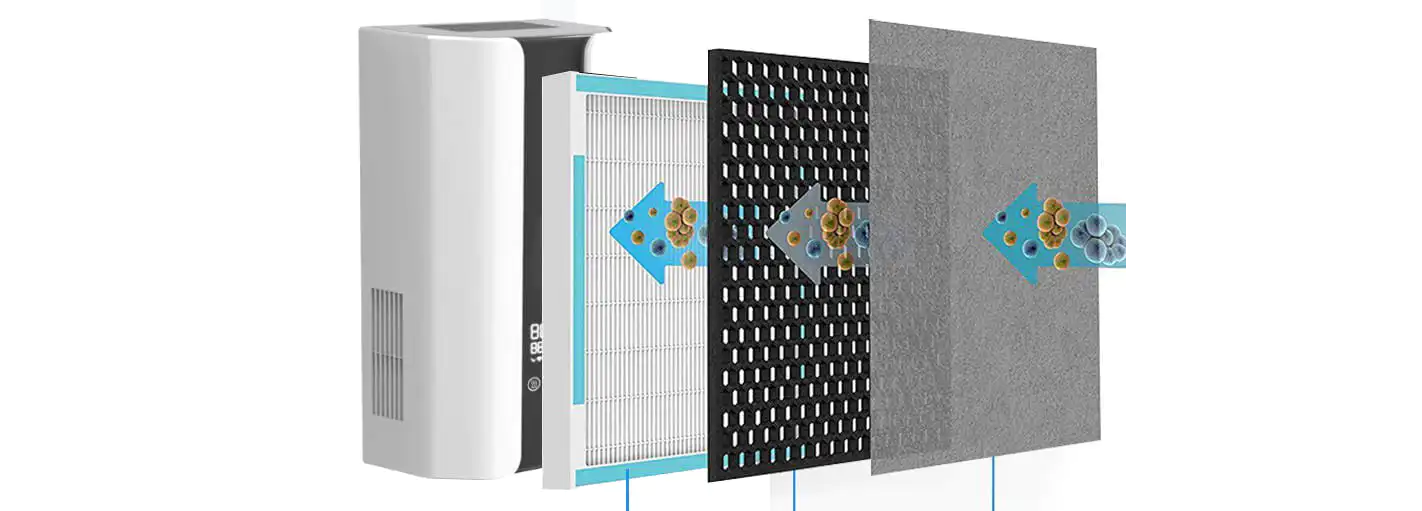1. What are the advantages of medical air purifiers?
Powerful disinfection, not just "filtration," but "elimination"
Medical air purifiers use medical-grade high-efficiency HEPA filters, achieving a single-pass filtration efficiency of up to 99.97% for particles as small as 0.3 microns. This means that common allergens such as pollen, dust mites, and pet dander have virtually nowhere to hide.
More importantly, some medical air purifiers have built-in UVC short-wave ultraviolet lamps. Ordinary purifiers only "capture" viruses on the filter, and they may still survive. UVC ultraviolet light, however, can directly destroy the DNA/RNA of viruses and bacteria, rendering them inactive, achieving true "capture and kill in one." This is crucial for preventing airborne diseases such as influenza and hand-foot-and-mouth disease.
Quiet operation, protecting sleep
We understand that a baby's sleep is extremely important. This purifier has been specially optimized in its fan and air duct design, operating at a whisper-like noise level in night mode. It silently purifies the air for your baby without disturbing their sweet dreams, giving mothers peace of mind.
Thoughtful Design, Everywhere You Look
Intelligent Monitoring: Real-time air quality display makes pollution visible. It automatically adjusts its purification speed when air quality deteriorates, making it smart and worry-free.
Safe Materials for Babies and Mothers: The product shell is made of non-toxic and harmless environmentally friendly materials, eliminating secondary pollution and ensuring safety even for curious babies.
Ultimate Sealing: Ensures that every breath of air drawn in undergoes rigorous purification, preventing dirty air from escaping through gaps and guaranteeing that the air at the outlet is always clean.

2. Working Principle of Medical Air Purifiers
First Layer: Physical Interception - High-Efficiency Filtration System
This is the foundation of all purification work, mainly achieved through layers of filters.
Pre-filter (Primary Filter)
Function: This is the first barrier to airflow, primarily responsible for intercepting larger particles such as hair, dust, and pollen.
Principle: A relatively sparse metal or plastic mesh that intercepts particles through physical pores.
Purpose: To protect the core HEPA filter behind it and extend its lifespan.
Medical-Grade HEPA Filter (Core of Core)
Function: Captures over 99.97% of 0.3-micron particles. This is crucial for removing allergens and viruses.
Target Particles: Pollen, dust mites, bacteria, smoke particles (PM2.5), and most importantly—virus-carrying droplet nuclei (aerosols). Although viruses themselves are small (approximately 0.1 microns), they mainly attach to 1-5 micron droplet nuclei in the air, thus being effectively captured by the HEPA filter.
Working Principle: It's not a simple "sieve," but rather combines three microscopic physical mechanisms:
Interception Effect: Larger particles directly collide with the fibers and are trapped.
Inertial Effect: Heavier particles, due to inertia, cannot follow the airflow around the fibers and are directly captured.
Diffusion Effect: Extremely small particles (e.g., <0.1 micrometers) undergo random Brownian motion due to collisions with air molecules, making them more likely to collide with the fibers and be captured.
(Particles of 0.3 micrometers are the most difficult to capture by any of the above mechanisms and are therefore defined as the "most easily penetrated particle size," which is the standard used in HEPA filters.)
Activated Carbon Filter
Function: Adsorbs gaseous pollutants, such as formaldehyde, VOCs (volatile organic compounds), secondhand smoke, and odors.
Principle: Activated carbon has a huge specific surface area and abundant microporous structure, allowing it to firmly adsorb gas molecules through intermolecular forces, much like a sponge.
Second Layer: Biochemical Inactivation - Deep Disinfection System
This is the dividing line between medical air purifiers and ordinary household air purifiers. It not only "captures" but also "kills" microorganisms.
UVC Short-Wave Ultraviolet Lamp
Function: Thoroughly inactivates captured bacteria and viruses.
Working Principle: Short-wave ultraviolet light with a wavelength of 253.7nm has extremely high energy, which can directly destroy the DNA or RNA structure of microorganisms (bacteria, viruses, molds), rendering them unable to replicate, thus achieving an "inactivation" effect.
Key Design: UVC lamps are usually installed behind HEPA filters or inside air ducts. In this way, the air first passes through a HEPA filter, and the intercepted microorganisms are then continuously irradiated by UVC, ensuring that they cannot grow on the filter and eventually die. This forms a closed loop of "filtration + inactivation," preventing secondary pollution.
Third Layer: Power Circulation - Environmental Purification Guarantee Purification capacity alone is insufficient; air must circulate throughout the entire space
High-Performance Fan and Duct Design
Function: Provides powerful suction and airflow, ensuring that indoor air is quickly and evenly drawn in and passes through the purification system.
Measurement: High CADR value. A higher CADR (Clean Air Delivery Rate) indicates faster purification speed and suitability for larger areas.
Purpose: To achieve rapid circulation and replacement of air throughout the house, ensuring no purification dead zones and effectively purifying the air in every corner of the room.

 EN
EN
 English
English 中文简体
中文简体
.png)









